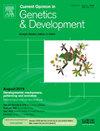Molecular basis of cell fate plasticity — insights from the privileged cells
IF 3.6
2区 生物学
Q2 CELL BIOLOGY
引用次数: 0
Abstract
In the post-Yamanaka era, the rolling balls on Waddington’s hilly landscape not only roll downward, but also go upward or sideways. This new-found mobility implies that the tantalizing somatic cell plasticity fueling regeneration, once only known to planarians and newts, might be sparking in the cells of mice and humans, if only we knew how to fully unlock it. The hope for ultimate regeneration was made even more tangible by the observations that partial reprogramming by the Yamanaka factors reverses many hallmarks of aging [76], even though the underlying mechanism remains unclear. We intend to revisit the milestones in the evolving understanding of cell fate plasticity and glean molecular insights from an unusual somatic cell state, the privileged cell state that reprograms in a manner defying the stochastic model. We synthesize our view of the molecular underpinning of cell fate plasticity, from which we speculate how to harness it for regeneration and rejuvenation. We propose that senescence, aging and malignancy represent distinct cell states with definable biochemical and biophysical parameters.
细胞命运可塑性的分子基础——来自特权细胞的见解
在后山中时代,沃丁顿丘陵景观上的滚动球不仅向下滚动,而且向上或侧向滚动。这种新发现的移动性意味着,曾经只有涡虫和蝾螈才知道的促进再生的诱人体细胞可塑性,如果我们知道如何完全解开它,可能会在老鼠和人类的细胞中激发出来。Yamanaka因子的部分重编程逆转了衰老的许多特征[76],尽管其潜在机制尚不清楚,但最终再生的希望变得更加切实。我们打算重新审视对细胞命运可塑性不断发展的理解中的里程碑,并从一种不寻常的体细胞状态中收集分子见解,这种特殊的细胞状态以一种藐视随机模型的方式重新编程。我们综合了我们对细胞命运可塑性的分子基础的看法,从中我们推测如何利用它进行再生和恢复。我们认为衰老、衰老和恶性肿瘤代表不同的细胞状态,具有可定义的生化和生物物理参数。
本文章由计算机程序翻译,如有差异,请以英文原文为准。
求助全文
约1分钟内获得全文
求助全文
来源期刊
CiteScore
7.90
自引率
0.00%
发文量
102
审稿时长
1 months
期刊介绍:
Current Opinion in Genetics and Development aims to stimulate scientifically grounded, interdisciplinary, multi-scale debate and exchange of ideas. It contains polished, concise and timely reviews and opinions, with particular emphasis on those articles published in the past two years. In addition to describing recent trends, the authors are encouraged to give their subjective opinion of the topics discussed.
In Current Opinion in Genetics and Development we help the reader by providing in a systematic manner:
1. The views of experts on current advances in their field in a clear and readable form.
2. Evaluations of the most interesting papers, annotated by experts, from the great wealth of original publications.[...]
The subject of Genetics and Development is divided into six themed sections, each of which is reviewed once a year:
• Cancer Genomics
• Genome Architecture and Expression
• Molecular and genetic basis of disease
• Developmental mechanisms, patterning and evolution
• Cell reprogramming, regeneration and repair
• Genetics of Human Origin / Evolutionary genetics (alternate years)

 求助内容:
求助内容: 应助结果提醒方式:
应助结果提醒方式:


